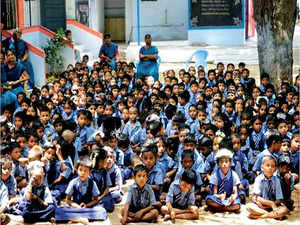
India’s public elementary schools are in deep crisis. Begin with enrolments. Nationally, the number of these schools has remained almost unchanged between 2010-11 and 2017-18. But the number of students has declined from 126.2 million to 102.3 million — a reduction of 23.9 million students.
The result: the average enrolment has fallen from 122 to just 99 pupils per school over the seven-year period. Compare these changes to those in recognised private schools. Nationally, the number of private elementary schools rose by 122,600, and their number of students by 21.2 million between 2010-11 and 2017-18. The average enrolment fell from 202 pupils per school to 191, but remained almost double that in public schools.
Abandoning Ship
By itself, this pattern is hardly worthy of the label ‘crisis’. For, it represents the familiar phenomenon of a shift away from public to private schools. The real crisis is uncovered when we disaggregate enrolments by school size defined in terms of number of students per school. As students have shifted to private schools over the last few decades, more and more public schools have emptied out with attendant deleterious effects on the cost per pupil as well as learning outcomes.
Already, in 2010-11, enrolments in 57% of public elementary schools in India had dropped to 100 or fewer students. The average number of pupils in these schools was just 51. The cost per pupil in teacher salary alone averaged Rs 16,650.
By 2017-18, the proportion of schools with 100 or fewer students shot up to 68%. Alongside, the average number of pupils in these schools declined to 45 per school, and the cost per pupil in teacher salary alone climbed steeply to Rs 39,300. This represented a compound annual growth rate of 13% in teacher salary cost per pupil.
To place this per pupil cost in perspective, it is 34% of per-capita GDP in India and 102% of per-capita gross state domestic product (GSDP) in Bihar in 2017-18. It boggles the mind to think whether an average Indian would ever consider spending such a large sum on her child’s school education on just tuition. Yet, this is what two-thirds of public elementary schools are doing.
Sadly, the true story is still worse for two reasons. First, according to recent reports by the Comptroller and Auditor General (CAG), official data overstate enrolments by as much as 20%, for reasons such as maximising midday meal allocations of grains provided by the government. Second, even the most liberal estimates would place student attendance on any given day at no higher than 80% on average.
Adjusting even for the second of these factors alone brings down the average attendance in a school with 100 or fewer students on any given day from 45 to 36. Then, making the extreme assumption that all elementary schools have only five grades, the average number of pupils per class works out to seven. This number is neither pedagogically viable nor economically efficient.
By now, most readers are familiar with the systematic evidence on learning outcomes produced by the NGO Pratham. This evidence shows that learning outcomes are not only low, but also declining over time. The same pattern is also observed in the National Achievement Survey of 5th graders between 2011 and 2015 conducted by the National Council of Educational Research and Training (NCERT). Is an expenditure of Rs 39,300 per pupil on teacher salary alone on imparting such education to the 31.7 million pupils in schools with 100 or fewer students fair to the taxpayer?
Good Money After Bad
Somewhat incredulously, the draft New Education Policy (NEP) nevertheless points to teacher shortage as one of the reasons for poor learning outcomes, and recommends hiring an additional one million teachers. At a salary of Rs 45,000 per month, these teachers would add a whopping Rs 54,000 crore to the taxpayer’s burden every year.
Lest the reader thinks that the low enrolments in the 68% of schools with 100 or fewer pupils are more than offset by significantly higher enrolments in the remaining public schools, thereby justifying the draft NEP recommendation, we hasten to add that even the pupil-teacher ratio (PTR) for all public elementary schools stands at 23 in 2017-18 — well below the prescribed norm of 30. Of the 20 largest states, PTR reaches 30 or more in only two states.
Therefore, any perceptions of teacher shortage represent their misallocation. The thought of sinking yet more public money into hiring new teachers seems especially frightening when we consider the complete disconnect between teacher salaries and student outcomes. In most countries, teacher salaries hover around per-capita income. But in India, they are five to seven times per-capita GDP with very little to show in terms of learning outcomes.
To overcome the crisis, the first point to recognise is that hiring more teachers is not the solution. Instead, we need to begin closing down unviable schools and reallocate teachers to where they are needed. If students from these schools so wish, the government should allow them to transfer to nearby private schools at its expense. Teachers who do not wish to be transferred may be offered voluntary retirement or jobs elsewhere in the government.
(Gandhi Kingdon is professor, Institute of Education, University College London, UK, and Panagariya is professor of economics, Columbia University, US)
Download The Economic Times News App to get Daily Market Updates & Live Business News.
Read More News on
Download The Economic Times News App to get Daily Market Updates & Live Business News.









 Get Unlimited Access to The Economic Times
Get Unlimited Access to The Economic Times
